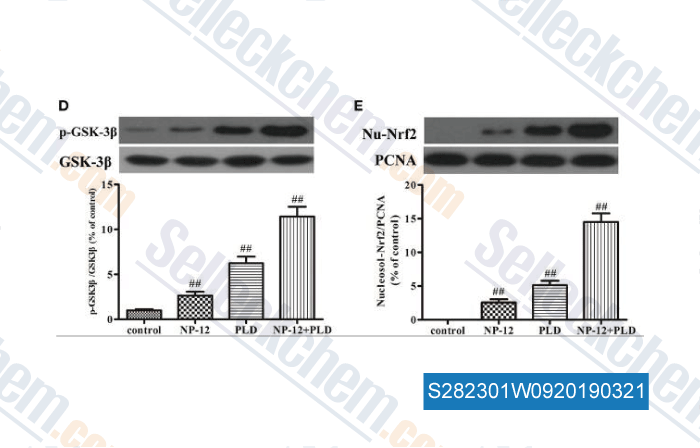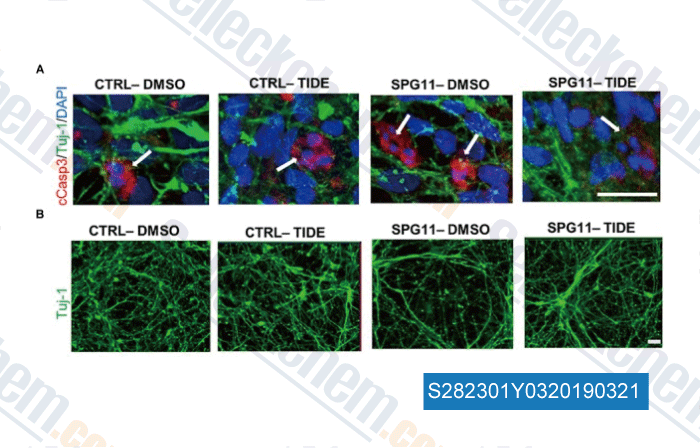|
Toll Free: (877) 796-6397 -- USA and Canada only -- |
Fax: +1-832-582-8590 Orders: +1-832-582-8158 |
Tech Support: +1-832-582-8158 Ext:3 Please provide your Order Number in the email. |
Technical Data
| Formula | C19H14N2O2S |
|||
| Molecular Weight | 334.39 | CAS No. | 865854-05-3 | |
| Solubility (25°C)* | In vitro | DMSO | 66 mg/mL (197.37 mM) | |
| Water | Insoluble | |||
| Ethanol | Insoluble | |||
|
* <1 mg/ml means slightly soluble or insoluble. * Please note that Selleck tests the solubility of all compounds in-house, and the actual solubility may differ slightly from published values. This is normal and is due to slight batch-to-batch variations. * Room temperature shipping (Stability testing shows this product can be shipped without any cooling measures.) |
||||
Preparing Stock Solutions
Biological Activity
| Description | Tideglusib is an irreversible, non ATP-competitive GSK-3β inhibitor with IC50 of 60 nM in a cell-free assay; fails to inhibit kinases with a Cys homologous to Cys-199 located in the active site. Phase 2. | ||
|---|---|---|---|
| Targets |
|
||
| In vitro | Tideglusib irreversibly inhibits GSK-3, reduces tau phosphorylation, and prevents apoptotic death in human neuroblastoma cells and murineprimary neurons. [1] Tideglusib (2.5 μM) inhibits glutamate-induced glial activation as evidenced by decreased TNF-α and COX-2 expression in rat primary astrocyte or microglial cultures. Tideglusib (2.5 μM) also exerts a potent neuroprotective effect on cortical neurons from glutamate-induced excitotoxicity as evidenced by significant reduction in the number of Annexin-V-positive cells in rat primary astrocyte or microglial cultures. [2] |
||
| In vivo | Tideglusib (50 mg/kg) injected into the adult male Wistar rats hippocampus dramatically reduces kainic acid-induced inflammation and has a neuroprotective effect in the damaged areas of the hippocampus. [2] Tideglusib (200 mg/kg, oral) results in lower levels of tau phosphorylation, decreased amyloid deposition and plaque-associated astrocytic proliferation, protection of neurons in the entorhinal cortex and CA1 hippocampal subfield against cell death, and prevention of memory deficits in APP/tau double transgenic mice. [3] |
Protocol (from reference)
| Kinase Assay: |
|
|---|---|
| Cell Assay: |
|
| Animal Study: |
|
References
Customer Product Validation

-
, , Ann Neurol, 2016, doi: 10.1002/ana.24633

-
Data from [Data independently produced by , , Front Immunol, 2018, 9:2527]

-
Data from [Data independently produced by , , Oncotarget, 2016, 7(12):13575-86]

-
Data from [Data independently produced by , , Front Neurosci, 2018, 12:914]
Selleck's Tideglusib has been cited by 28 publications
| The TRIM4 E3 ubiquitin ligase degrades TPL2 and is modulated by oncogenic KRAS [ Cell Rep, 2024, 43(9):114667] | PubMed: 39178114 |
| Activity and inhibition of the SARS-CoV-2 Omicron nsp13 R392C variant using RNA duplex unwinding assays [ SLAS Discov, 2024, S2472-5552(24)00007-8] | PubMed: 38301954 |
| SYK coordinates neuroprotective microglial responses in neurodegenerative disease [ Cell, 2022, 185(22):4135-4152.e22] | PubMed: 36257314 |
| Starvation mediates pancreatic cancer cell sensitivity to ferroptosis via ERK1/2, JNK and changes in the cell mesenchymal state [ Int J Mol Med, 2022, 49(6)84] | PubMed: 35514314 |
| The kinase complex mTORC2 promotes the longevity of virus-specific memory CD4+ T cells by preventing ferroptosis [ Nat Immunol, 2021, 10.1038/s41590-021-01090-1] | PubMed: 34949833 |
| Evaluating a New Class of AKT/mTOR Activators for HIV Latency-Reversing ActivityEx VivoandIn Vivo [ Journal of Virology, 2021, 95(8)] | PubMed: None |
| Evaluating a New Class of AKT/mTOR Activators for HIV Latency Reversing Activity Ex Vivo and In Vivo [ J Virol, 2021, JVI.02393-20] | PubMed: 33536176 |
| Sensitivity of pancreatic cancer cells to chemotherapeutic drugs, signal transduction inhibitors and nutraceuticals can be regulated by WT-TP53 [ Adv Biol Regul, 2021, S2212-4926(20)30091-9] | PubMed: 33451973 |
| Actionable Cytopathogenic Host Responses of Human Alveolar Type 2 Cells to SARS-CoV-2 [ Mol Cell, 2020, 80(6):1104-1122.e9] | PubMed: 33259812 |
| Bidirectional Regulation between NDRG1 and GSK3β Controls Tumor Growth and Is Targeted by Differentiation Inducing Factor-1 in Glioblastoma. [ Cancer Res, 2020, 80(2):234-248] | PubMed: 31723002 |
RETURN POLICY
Selleck Chemical’s Unconditional Return Policy ensures a smooth online shopping experience for our customers. If you are in any way unsatisfied with your purchase, you may return any item(s) within 7 days of receiving it. In the event of product quality issues, either protocol related or product related problems, you may return any item(s) within 365 days from the original purchase date. Please follow the instructions below when returning products.
SHIPPING AND STORAGE
Selleck products are transported at room temperature. If you receive the product at room temperature, please rest assured, the Selleck Quality Inspection Department has conducted experiments to verify that the normal temperature placement of one month will not affect the biological activity of powder products. After collecting, please store the product according to the requirements described in the datasheet. Most Selleck products are stable under the recommended conditions.
NOT FOR HUMAN, VETERINARY DIAGNOSTIC OR THERAPEUTIC USE.
